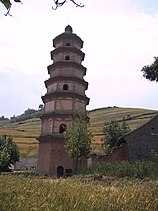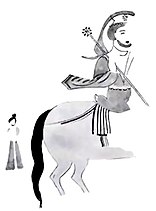[경교] 경교에 왜 관심이 많은가?
사실 한국 기독교와 경교는 상관이 없다. 그 유산이 전달되지 않았고 단절되었기 때문이다. 일종의 고고학적 관심이나 관광/상업적 이익 때문에 공부한다면 찬성, 그러나 현재 계승하거나 한국교회에 도움이 될 만한 유산을 찾기는 어렵기 때문에 본격적 연구는 반대.
아무튼 경교는 '이단'이었다. 경교는 중국 선교로 정통성을 확보하려고 노력했으나, 결국 실패했다.
경교의 신라 전래에 대한 증거는 아직 없다. 발해 유물도 기독교 융성과 별로 상관이 없다. 만주의 무당이나 도교 승려도 얼마든지 그런 십자가를 이용하던 시절이었다.
일본에서는 일찍 경교 연구가 진행되었다. 일종의 오타쿠적 연구 경향도 보인다. 일본에는 온갖 연구 그룹이 있다. 사라진 10지파 유대인 연구도 활발하다. 경교 연구는 일본 선민/神民 의식과 연결된다. 조심할 일이다.
그래도 공부하려면
Peter Yoshirō Saeki, The Nestorian Documents and Relics in China (The Toho Bunkwa Gakuin: The Academy of Oriental Culture Tokyo Institute, The Maruzen Company LTD, 1951) 景敎의 대학자였던 佐伯好郎의 저서부터 읽기 바란다.
중국 학계의 경교 연구는 깊이가 있고, 만주와 그 너머의 연구에는 배울 게 있다.
경교 연구 노력을 한국 교회사나 교회 개혁안 연구에 들이기를^^
JiHoon Suk
선생님께서도 (저보다 더욱) 잘 아시겠지만 아직도 일각에서는 신라 경교 전래설을 밀어붙이면서 모처에 소장된 "경주출토 유물" 운운하며 호도하는 경향이 있는데 그거에 꽤 많은 사람들이 넘어가서 안타까울 따름입니다.
===Nestorianism, Christian sect that originated in Asia Minor and Syria stressing the independence of the divine and human natures of Christ and, in effect, suggesting that they are two persons loosely united.2023. 4. 12.Nestorianism | Definition, History, & Churches | Britannicabritannica.com====네스토리우스파
위키백과, 우리 모두의 백과사전. 경교는 여기로 연결됩니다. 다른 뜻에 대해서는 경교 (동음이의) 문서를 참고하십시오.
경교는 여기로 연결됩니다. 다른 뜻에 대해서는 경교 (동음이의) 문서를 참고하십시오.기독교 기초경전기독교 관련 설화기타 일반네스토리우스파(Nestorianism) 또는 경교(景敎)는 콘스탄티노폴리스 총대주교 네스토리우스(?년 ∼ 451?년)를 시조로 하는 기독교의 일파를 말한다. 아시리아 동방교회로 소급된다.
교의[편집]
그리스도의 위격은 하나가 아니며, 신격과 인격이라는 두 개의 성격으로 분리 구별된다고 보았다(이성설二性說). 이것은 구세주(그리스도)의 신격은 예수의 복음서에 깃들고 인격은 사라진 육신 안에 있음을 의미한다는 것이다. 이 경우 인성으로써 예수를 낳은 성모 마리아에게는 하느님의 어머니(테오토코스, Θεοτοκος)라는 호칭을 사용할 수 없다고 주장하였고, 결국 431년 에페소스 공의회에서 이단으로 판정된 네스토리우스는 면직 파문되어 리비아로 추방되었다.
역사[편집]
개요[편집]
그리스도론 논쟁[편집]
알렉산드리아 학파 출신의 알렉산드리아 총대주교 키릴로스와 안티오키아 학파 출신의 콘스탄티누폴리스 총대주교 네스토리우스 사이의 갈등에서 시작되었다. 네스토리우스는 그때까지 고대 교부(敎父)들이 마리아에 대해 사용하던 칭호 테오도코스(Θεοτοκος : 테오스 곧 하느님θεος을 낳은 자τοκος)를 부정하고, 마리아는 크리스토토코스(Χριστοτόκος : 크리스토스 곧 그리스도 Χριστος을 낳은 자 τοκος)라고 주장하였다. 그 이유는 예수는 신성과 인성이라는 두 개의 위격(휘포스타시스, υποστασις)이지만, 마리아는 어디까지나 인간적 위격(인격)을 낳았을 뿐이라는 것이었다. 반면 키릴로스는 그리스도의 본성(피시스, φυσις)은 신성과 인성으로 구별되지만 위격로서는 유일하다(위격적 연합, Hypostatic Union, ένωσις καθ΄ υπόστασιν)며 반박했다.
에페소 공의회[편집]
네스토리우스는 에페소 또는 에베소 공의회에 참석을 거부했고, 네스토리우스가 에페소 공의회에서 파문된 뒤 네스토리우스파 기독교는 498년에 크테시폰 셀레우키아(Seleucia)에 새로운 총대주교를 세웠다. 7세기 중기까지 페르시아 일대의 네스토리우스파 기독교 곧 경교에 대해서는 《시일토 연대기》에 상세하게 나와있다. 현재는 이라크 북부의 아시리아 지역에 산재하고 있으며 미국과 호주 이민자를 중심으로 신도가 존재하고 있다.
가톨릭으로의 복귀[편집]
네스토리우스파 교회인 아시리아 동방교회(정교회와는 별개의 계통)의 일부는 1553년에 가톨릭교회로 돌아와(Sulaqa) 칼데아 전례 가톨릭 교회(동방귀일교회, 동방전례 가톨릭 교회의 하나)라 불리게 되었다. 아시리아 동방교회와 칼데아 가톨릭교회는 현재도 서아시아의 아시리아(현재 이라크 북부)에서 활동하고 있다.
동방 기독교[편집]
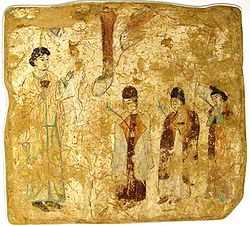 7~8세기경 중국에 전래된 경교의 전례(성지주일을 묘사한 것)
7~8세기경 중국에 전래된 경교의 전례(성지주일을 묘사한 것) 이 부분의 본문은 대진사입니다.
이 부분의 본문은 대진사입니다.네스토리우스의 신학은 424년경부터 이집트, 시리아, 팔레스티나 지방 및 인도까지도 전파되었다.
경교라 불리다[편집]
당 태종 때인 7세기에는 중국 대륙에도 전래되었다. 페르시아인 경교 사제인 「아라본」(阿羅本) 등에 의해 전래된 네스토리우스교는 경교(景敎)라 불렸고, 경교 교회를 페르시아 교회라는 뜻인 파사사(波斯寺)라고도 불렀다. 경교라는 이름은 중국어로 빛의 신앙이라는 의미가 있으며, 당 현종(玄宗) 때에는 경교 교회인 파사사는 대진사(大秦寺)라 개칭하고, 각지에 교회를 건립하여 교세를 제법 떨쳤다고 전해진다.
탄압으로 소멸하다[편집]
초기 당 조정은 황족을 포함한 지배계급에 북방 유목민족(선비, 흉노)요소가 농후하였고 경교, 불교 등의 비(非)중화종교에 대해서도 너그러움을 보였으며 그들의 신앙은 너그러움과 보호를 받으며 2백 년 동안 번성하였다. 그러나 당 말기 왕조를 전통적인 중화 왕조의 위치를 굳건히 하게 된 뒤 탄압으로 소멸하였다(참고: 회창의 폐불).
원나라 시대[편집]
몽골 제국의 원(元) 왕조 치하에서는 경교가 허락되어 기독교 신자와 교회가 증가하였고 그때는 복음을 따르는 무리라는 뜻의 예르게운(야리가온)이라 불리었다. 몽골 제국을 구성하게 될 몇몇 북방 유목민들에게도 포교되어 칭기즈 칸 계통의 일부 가계나 이들과 사돈 관계에 있는 몽골 제국의 정치적 중추를 구성하는 일족으로서 경교를 열심히 믿는 유목 집단이 많았다. 그래서 전 시대에 일시 중국 본토에서도 부활하게 됐다. 다만, 몽골 제국이 붕괴된 뒤, 제국의 중추를 구성하고 있던 여러 유목 집단은 서쪽에서는 이슬람과 터키계 언어를 수용하여 튀르크(터키인)을 자칭하게 되고, 동방에서는 티베트 불교를 신앙해 몽골어 계통의 언어를 유지한 몽골을 자칭하는 세력과 오이라트를 칭하는 세력의 양대 세력으로 나뉘며, 네스토리우스파 기독교 곧 경교를 믿던 유목 집단은 그 사이에서 매몰, 소멸하고 말았다.
한반도 전래설[편집]
한반도에서는 당(唐)과 빈번한 문화적 교류를 가졌던 남북국 시대인 8~9세기 경 발해와 신라에 경교가 전래되었을 가능성이 제기되었다. 이러한 주장은 '돌십자가', '십자무늬장식' 등 경교와 관련된 것으로 추정되는 유물의 발견에 근거하고 있다.[1]
같이 보기[편집]

위키미디어 공용에 관련된
미디어 분류가 있습니다.각주
===
Nestorianism
| Part of a series on |
| Christology |
|---|
Concepts |
Doctrines |
Nestorianism is a term used in Christian theology and Church history to refer to several mutually related but doctrinarily distinct sets of teachings.[1]
The first meaning of the term is related to the original teachings of Christian theologian Nestorius (d. c. 450 AD), who promoted specific doctrines in the fields of Christology and Mariology.
The second meaning of the term is much wider, and relates to a set of later theological teachings, that were traditionally labeled as Nestorian, but differ from the teachings of Nestorius in origin, scope and terminology.[2]
The Oxford English Dictionary defines Nestorianism as "The doctrine of Nestorius, patriarch of Constantinople (appointed in 428), by which Christ is asserted to have had distinct human and divine persons."[3]
Original Nestorianism is attested primarily by works of Nestorius, and also by other theological and historical sources that are related to his teachings in the fields of Mariology and Christology. His theology was influenced by teachings of Theodore of Mopsuestia (d. 428), the most prominent theologian of the Antiochian School. Nestorian Mariology rejects the title Theotokos ('God-bearer') for Mary, thus emphasizing distinction between divine and human aspects of the Incarnation. Nestorian Christology promotes the concept of a prosopic union of two natures (divine and human) in Jesus Christ,[4] thus trying to avoid and replace the concept of a hypostatic union. This Christological position is defined as radical dyophysitism,[5] and differs from orthodox dyophysitism, that was reaffirmed at the Council of Chalcedon (451).[6] Such teachings brought Nestorius into conflict with other prominent church leaders, most notably Cyril of Alexandria, who issued 12 anathemas against him (430). Nestorius and his teachings were eventually condemned as heretical at the Council of Ephesus in 431, and again at the Council of Chalcedon in 451. His teachings were considered as heretical not only in Chalcedonian Christianity, but even more in Oriental Orthodoxy.[6]
After the condemnation, some supporters of Nestorius, who were followers of the Antiochian School and the School of Edessa, relocated to the Sasanian Empire, where they were affiliated with the local Christian community, known as the Church of the East. During the period from 484 to 612, gradual development led to the creation of specific doctrinal views within the Church of the East.[7] Evolution of those views was finalized by prominent East Syriac theologian Babai the Great (d. 628) who was using the specific Syriac term qnoma (ܩܢܘܡܐ) as a designation for dual (divine and human) substances within one prosopon (person or hypostasis) of Christ. Such views were officially adopted by the Church of the East at a council held in 612.[8] Opponents of such views labeled them as "Nestorian" thus creating the practice of misnaming the Church of the East as Nestorian.[9] For a long time, such labeling seemed appropriate, since Nestorius is officially venerated as a saint in the Church of the East.[10] In modern religious studies, this label has been criticized as improper and misleading.[11] As a consequence, the use of Nestorian label in scholarly literature, and also in the field of inter-denominational relations, is gradually being reduced to its primary meaning, focused on the original teachings of Nestorius.[12]
History[edit]
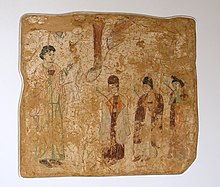
Nestorianism was condemned as heresy at the Council of Ephesus (431). The Armenian Church rejected the Council of Chalcedon (451) because they believed Chalcedonian Definition was too similar to Nestorianism. The Persian Nestorian Church, on the other hand, supported the spread of Nestorianism in Persarmenia. The Armenian Church and other eastern churches saw the rise of Nestorianism as a threat to the independence of their Church. Peter the Iberian, a Georgian prince, also strongly opposed the Chalcedonian Creed.[13] Thus, in 491, Catholicos Babken I of Armenia, along with the Albanian and Iberian bishops met in Vagharshapat and issued a condemnation of the Chalcedonian Definition.[14]
Nestorians held that the Council of Chalcedon proved the orthodoxy of their faith and had started persecuting non-Chalcedonian or Miaphysite Syriac Christians during the reign of Peroz I. In response to pleas for assistance from the Syriac Church, Armenian prelates issued a letter addressed to Persian Christians reaffirming their condemnation of the Nestorianism as heresy.[13]
Following the exodus to Persia, scholars expanded on the teachings of Nestorius and his mentors, particularly after the relocation of the School of Edessa to the (then) Persian city of Nisibis (modern-day Nusaybin in Turkey) in 489, where it became known as the School of Nisibis.[citation needed] Nestorian monasteries propagating the teachings of the Nisibis school flourished in 6th century Persarmenia.[13]
Despite this initial Eastern expansion, the Nestorians' missionary success was eventually deterred. David J. Bosch observes, "By the end of the fourteenth century, however, the Nestorian and other churches—which at one time had dotted the landscape of all of Central and even parts of East Asia—were all but wiped out. Isolated pockets of Christianity survived only in India. The religious victors on the vast Central Asian mission field of the Nestorians were Islam and Buddhism".[15]
Doctrine[edit]


Nestorianism is a radical form of dyophysitism,[5] differing from orthodox dyophysitism on several points, mainly by opposition to the concept of hypostatic union. It can be seen as the antithesis to Eutychian Monophysitism, which emerged in reaction to Nestorianism. Where Nestorianism holds that Christ had two loosely united natures, divine and human, Monophysitism holds that he had but a single nature, his human nature being absorbed into his divinity. A brief definition of Nestorian Christology can be given as: "Jesus Christ, who is not identical with the Son but personally united with the Son, who lives in him, is one hypostasis and one nature: human."[17] This contrasts with Nestorius' own teaching that the Word, which is eternal, and the Flesh, which is not, came together in a hypostatic union, 'Jesus Christ', Jesus thus being both fully man and God, of two ousia (Ancient Greek: οὐσία) (essences) but of one prosopon (person).[18] Both Nestorianism and Monophysitism were condemned as heretical at the Council of Chalcedon.
Nestorius developed his Christological views as an attempt to understand and explain rationally the incarnation of the divine Logos, the Second Person of the Holy Trinity as the man Jesus. He had studied at the School of Antioch where his mentor had been Theodore of Mopsuestia; Theodore and other Antioch theologians had long taught a literalist interpretation of the Bible and stressed the distinctiveness of the human and divine natures of Jesus. Nestorius took his Antiochene leanings with him when he was appointed Patriarch of Constantinople by Byzantine emperor Theodosius II in 428.
Nestorius's teachings became the root of controversy when he publicly challenged the long-used title Theotokos[19] ('God-Bearer') for Mary. He suggested that the title denied Christ's full humanity, arguing instead that Jesus had two persons (dyoprosopism),[20] the divine Logos and the human Jesus. As a result of this prosopic duality, he proposed Christotokos ('Christ-Bearer') as a more suitable title for Mary. He also advanced the image of Jesus as a warrior-king and rescuer of Israel over the traditional image of the Christus dolens.[21]
Nestorius' opponents found his teaching too close to the heresy of adoptionism – the idea that Christ had been born a man who had later been "adopted" as God's son. Nestorius was especially criticized by Cyril, Patriarch of Alexandria, who argued that Nestorius's teachings undermined the unity of Christ's divine and human natures at the Incarnation. Some of Nestorius's opponents argued that he put too much emphasis on the human nature of Christ, and others debated that the difference that Nestorius implied between the human nature and the divine nature created a fracture in the singularity of Christ, thus creating two Christ figures.[22] Nestorius himself always insisted that his views were orthodox, though they were deemed heretical at the Council of Ephesus in 431, leading to the Nestorian Schism, when churches supportive of Nestorius and the rest of the Christian Church separated. However, this formulation was never adopted by all churches termed 'Nestorian'. Indeed, the modern Assyrian Church of the East, which reveres Nestorius, does not fully subscribe to Nestorian doctrine, though it does not employ the title Theotokos.[23]
Nestorian Schism[edit]
Nestorianism became a distinct sect following the Nestorian Schism, beginning in the 430s. Nestorius had come under fire from Western theologians, most notably Cyril of Alexandria. Cyril had both theological and political reasons for attacking Nestorius; on top of feeling that Nestorianism was an error against true belief, he also wanted to denigrate the head of a competing patriarchate.[citation needed] Cyril and Nestorius asked Pope Celestine I to weigh in on the matter. Celestine found that the title Theotokos[19] was orthodox, and authorized Cyril to ask Nestorius to recant. Cyril, however, used the opportunity to further attack Nestorius, who pleaded with Emperor Theodosius II to call a council so that all grievances could be aired.[23]
In 431 Theodosius called the Council of Ephesus. However, the council ultimately sided with Cyril, who held that the Christ contained two natures in one divine person (hypostasis, unity of subsistence), and that the Virgin Mary, conceiving and bearing this divine person, is truly called the Mother of God (Theotokos). The council accused Nestorius of heresy, and deposed him as patriarch.[24] Upon returning to his monastery in 436, he was banished to Upper Egypt. Nestorianism was officially anathematized, a ruling reiterated at the Council of Chalcedon in 451. However, a number of churches, particularly those associated with the School of Edessa, supported Nestorius – though not necessarily his doctrine – and broke with the churches of the West. Many of Nestorius' supporters relocated to the Sasanian Empire of Iran, home to a vibrant but persecuted Christian minority.[25] In Upper Egypt, Nestorius wrote his Book of Heraclides, responding to the two councils at Ephesus (431, 449).[18]
Christian denomination tree[edit]

- (Not shown are non-Nicene, nontrinitarian, and some restorationist denominations.)
Church of the East[edit]


The western provinces of the Persian Empire had been home to Christian communities, headed by metropolitans, and later patriarchs of Seleucia-Ctesiphon. The Christian minority in Persia was frequently persecuted by the Zoroastrian majority, which accused local Christians of political leanings towards the Roman Empire. In 424, the Church in Persia declared itself independent, in order to ward off allegations of any foreign allegiance. By the end of the 5th century, the Persian Church increasingly aligned itself with the teachings of Theodore of Mopsuestia and his followers, many of whom became dissidents after the Councils of Ephesus (431) and Chalcedon (451). The Persian Church became increasingly opposed to doctrines promoted by those councils, thus furthering the divide between Chalcedonian and Persian currents.[6]
In 486, the Metropolitan Barsauma of Nisibis publicly accepted Nestorius' mentor Theodore of Mopsuestia as a spiritual authority. In 489, when the School of Edessa in Mesopotamia was closed by Byzantine Emperor Zeno for its pro-Nestorian teachings, the school relocated to its original home of Nisibis, becoming again the School of Nisibis, leading to the migration of a wave of Christian dissidents into Persia. The Persian patriarch Babai (497–502) reiterated and expanded upon the church's esteem for Theodore of Mopsuestia.
Now firmly established in Persia, with centers in Nisibis, Ctesiphon, and Gundeshapur, and several metropoleis, the Persian Church began to branch out beyond the Sasanian Empire. However, through the sixth century, the church was frequently beset with internal strife and persecution by Zoroastrians. The infighting led to a schism, which lasted from 521 until around 539 when the issues were resolved. However, immediately afterward Roman-Persian conflict led to the persecution of the church by the Sassanid emperor Khosrow I; this ended in 545. The church survived these trials under the guidance of Patriarch Aba I, who had converted to Christianity from Zoroastrianism.[25]
The church emerged stronger after this period of ordeal, and increased missionary efforts farther afield. Missionaries established dioceses in the Arabian Peninsula and India (the Saint Thomas Christians). They made some advances in Egypt, despite the strong Miaphysite presence there.[26] Missionaries entered Central Asia and had significant success converting local Turkic tribes.
The Anuradhapura Cross discovered in Sri Lanka strongly suggests a strong presence of Nestorian Christianity in Sri Lanka during the 6th century AD according to Humphrey Codrington, who based his claim on a 6th-century manuscript, Christian Topography, that mentions of a community of Persian Christians who were known to reside in Taprobanê (the Ancient Greek name for Sri Lanka).[27][28][29]
Nestorian missionaries were firmly established in China during the early part of the Tang dynasty (618–907); the Chinese source known as the Nestorian Stele records a mission under a Persian proselyte named Alopen as introducing Nestorian Christianity to China in 635. The Jingjiao Documents (also described by The Japanese scholar P. Y. Saeki as "Nestorian Documents") or Jesus Sutras are said to be connected with Alopen.[30]
Following the Arab conquest of Persia, completed in 644, the Persian Church became a dhimmi community under the Rashidun Caliphate. The church and its communities abroad grew larger under the Caliphate. By the 10th century it had 15 metropolitan sees within the Caliphate's territories, and another five elsewhere, including in China and India.[25] After that time, however, Nestorianism went into decline.[disputed – discuss]
Assyrian Church of the East[edit]
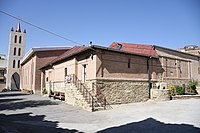
In a 1996 article published in the Bulletin of the John Rylands Library, Fellow of the British Academy Sebastian Brock wrote: "the term 'Nestorian Church' has become the standard designation for the ancient oriental church which in the past called itself 'The Church of the East', but which today prefers the fuller title 'The Assyrian Church of the East'. The Common Christological Declaration between the Catholic Church and the Assyrian Church of the East signed by Pope John Paul II and Mar Dinkha IV underlines the Chalcedonian Christological formulation as the expression of the common faith of these Churches and recognizes the legitimacy of the title Theotokos."[31]
In a 2017 paper, Mar Awa Royel, Bishop of the Assyrian Church, stated the position of that church: "After the Council of Ephesus (431), when Nestorius the patriarch of Constantinople was condemned for his views on the unity of the Godhead and the humanity in Christ, the Church of the East was branded as 'Nestorian' on account of its refusal to anathematize the patriarch."[32]
Several historical records suggest that the Assyrian Church of the East may have been in Sri Lanka between the mid-5th and 6th centuries.[27][28][29]


